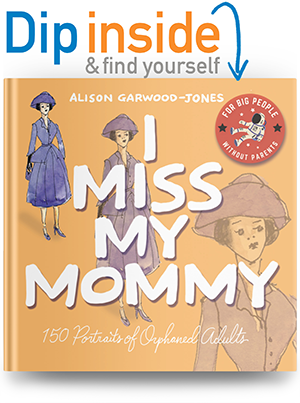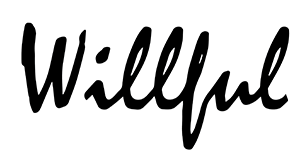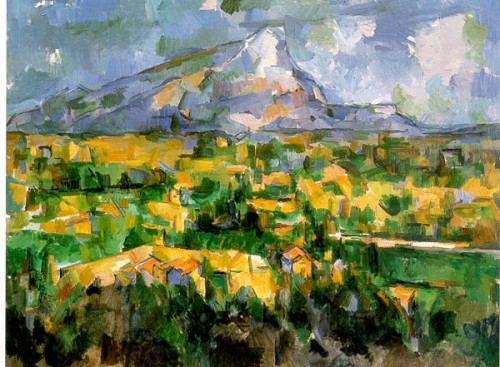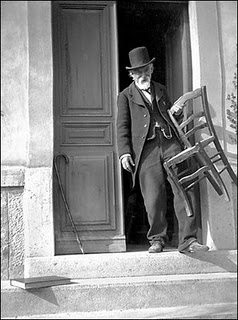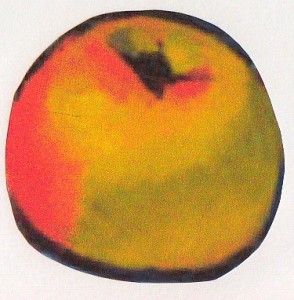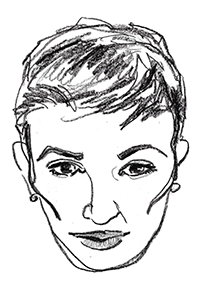An apple a day
November 2, 2017
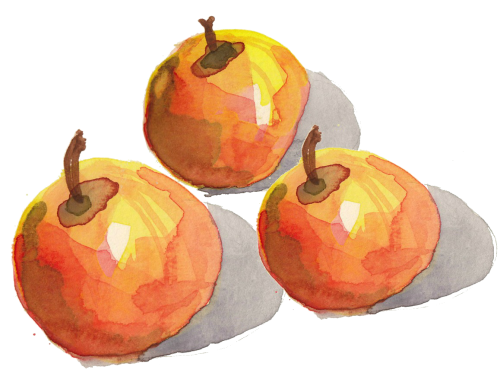
Yesterday, as I thought more deeply about the loony collapse of the United States (see Kurt Andersen), and all the people down there who appear to be cheering on the destablization of entire systems of meaning (see Stephen Marche), I picked up a makeup brush I’ve never used on my face and painted some apples. Because that’s what you do when humans confound you, you turn to nature for expressions of truth.
Mastering watercolour glazes has been on my To Do List for months. Switching brushes — from a no. 6 round to a Chinese-style makeup brush — was a good move. I’m getting better at laying down broad swaths of colour with soft, wobbly brushes and waiting for them to dry. Patience is key. The resulting magic is a balm. I like them apples.
It’s impossible — for me, anyway — to paint an apple without thinking of Paul Cézanne, the French Post-Impressionist painter. I’m an art history major whose neural pathways have been carved by years of slide lectures. I even wrote an entire Master’s Thesis on Cézanne’s art.
Paul was an ornery guy who didn’t understand himself, or anyone else for that matter. Humans were a mystery to him. Art was his excuse for avoiding all unecessary contact with their stupidities and gross habits. His art focused on volume, not light (like Monet). Exalting volume made him feel more whole, more grounded as an artist and a person.
Other people use food to get that same feeling. Barbra Streisand is so nervous about the current political situation in the United States, she ate her way through this interview with Alec Baldwin. She is very aware that the changes to her eating habits since last November are turning into a problem. I think she should go back to making art. A new song or a new movie would curb her appetite.
I wrote about Cézanne a couple of years ago on this blog. Let’s revisit his life.

Cézanne was a grumbler, a mumbler and a first-class curmudgeon. He was the sort of guy who would fling open his shutters and scream at distant barking dogs if they were interrupting his thought process. It’s not what you’d expect of a resident of Provence, that bourgeois mecca for cooking show enthusiasts and coffee table book collectors. In short, he was the Boo Radley of Aix.
Neighbourhood boys would hide behind bushes waiting for Cézanne to leave his studio so they could pelt stones at him as he ambled along the crunchy gravel paths leading to the summit of his beloved Mont Sainte-Victoire. He’d scream and wave his cane at them. Even his coachman got an earful: “You what? You raised the price of the carriage to Château Noir to three francs return? You’re fired!” (the current associations with that phrase are unfortunate).
Not surprisingly, Paul’s wife, Hortense lived elsewhere. But it was better that way. She was an inveterate gambler and spent more time in casinos than art galleries. One bad match turned Cézanne off all other future prospects. Women freaked him out. That uneasy relationship to the fair sex made him replace the female model he needed for his bather paintings with marble sculptures. He loved his son, but only stayed in contact with him through letters.
Today Cézanne’s shoe prints are cast in metal along a number of Provencal roads and paths he regularly walked on. I followed them like a dance chart the last time I was in Aix. He would have hated being hounded like this, but hundreds of thousands of people do it every year.
Cézanne never hid the fact that life overwhelmed and confused him. That’s why his art and biography resist the rosy, romantic haze that’s settled over Monet and Renoir, and why many people, including this writer, appreciate how persistent he was in trying to resolve his confusion through art.
That confusion made him ill-mannered and probably paranoid — in short, not the sort of guy you’d invite to parties. His contemporary, Toulouse Lautrec, knew how to whoop it up. And records show that Manet was courtly to his core and great dinner party guest. Not Cézanne. Here’s what I mean, “All my compatriots are hogs compared to me,” he wrote in a letter to his son. “I can never get away from the meanness of people, be it theft, complacency, infatuation or violation, the seizing of my work. And yet nature is beautiful.” But even that beauty caused him pain. “I’m so slow at realizing my ideas and that makes me very sad,” he said.
One day, while painting only a few hundred yards from his studio, the clouds turned black and boiling and a thunderstorm cracked the sky in two. But Cézanne kept painting through the lashing rain. “I cannot attain the intensity unfolding before my senses.”
He continued his outdoor research because painting was his consolation against life. A few hours later, a laundry cart picked him up and two men placed him on his bed. If Cézanne were a novel, William Styron would have written it and Alan J. Pakula would have directed the movie.
Cézanne turned to painting like prayer (God didn’t have his ear). It was a daily ritual, part of his search for answers, and a way of giving thanks for the abundance of beauty around him. To give order to the barrage of sensations fighting for attention in his chatty mind, he developed a painting stroke that organized colour into something that looks like a lineup of mosaic tiles. Renoir’s strokes were fluffy, Seurat’s dotty, but Cézanne’s strokes clicked together like puzzle pieces, or piano keys.
There’s a beat to the order of his brushstrokes that holds you in front of his paintings before you realize you better move on, other people need to look. To me it feels like tribal music. The strokes take control of the rhythm of my heart. Everything Cézanne saw and painted got that treatment, from the mountain all the way down to an apple.
Google doodle
January 20, 2011
Cézanne was a Google doodle yesterday. That’s because he turned 172.
I was glad to see he made it into this digital pantheon.
 See? It spells out G-o-o-g-l-e
See? It spells out G-o-o-g-l-e
Usually the kids at Google HQ reserve the space around their name for astronauts and civil rights leaders — you know, more splashy role models. I wouldn’t even say Cézanne is that well known outside the art world. He wasn’t an Impressionist, even though he was French and lived through that period. His brushstrokes and palette took him in a different direction which landed him on fewer umbrellas and tote bags. But I like the guy, despite my better judgement. And I love his art.
Cézanne was a grumbler, a mumbler and a first-class curmudgeon, the sort of guy who’d fling open his shutters and scream at distant barking dogs when they interrupted his thought process (not what you’d expect of a resident of Provence, now that bourgeois mecca for cooking show enthusiasts and coffee table book collectors). In short, he was the Boo Radley of Aix. Neighbourhood boys would hide behind bushes waiting for Cézanne to leave his apartment so they could pelt stones at him as he ambled along the crunchy gravel paths leading to the summit of his beloved Mont Sainte-Victoire (pictured above). He’d scream and wave his cane at them. Even his coachman got an earful: “You what? You raised the price of the carriage to Château Noir to three francs return? You’re fired!”
Not surprisingly, his wife Hortense lived elsewhere. But it was better that way. She was an inveterate gambler and spent more time in casinos than art galleries. One bad match turned Cézanne off all other future prospects. It also made him replace the female model he needed for his art with marble sculptures. He did stay in close contact with his son, though, but only through letters.
Today Cézanne’s shoe prints are cast in metal along a number of roads and paths he regularly took. I followed them like a dance chart the last time I was in Aix. He would have hated being hounded like this. But hundreds of thousands of people do it every year.
Here’s Cézanne taking a chair out into his garden so he can paint. Watch out for stone missiles, old man!
To his detriment, I suppose, Cézanne never hid the fact that life overwhelmed and confused him. That’s why his art and biography resist the rosy, romantic haze that’s settled over Monet and Renoir, and why many people, including me, appreciate how persistent he was in trying to resolve his confusion through art.
That confusion made him ill-mannered and probably paranoid — in short, not the sort of guy you’d invite to parties (Toulouse Lautrec knew how to whoop it up, while Manet was courtly to his core and great dinner party guest). Not Cézanne. Here’s what I mean, “All my compatriots are hogs compared to me,” he wrote in a letter to his son. “I can never get away from the meanness of people, be it theft, complacency, infatuation or violation, the seizing of my work. And yet nature is beautiful.” But even that beauty caused him pain. “I’m so slow at realizing my ideas and that makes me very sad,” he said.
One day, while painting only a few hundred yards from his studio the clouds turned black and boiling and a thunderstorm cracked the sky in two. But Cézanne kept painting through the lashing rain. “I cannot attain the intensity unfolding before my senses.” He continued his research indefatigably because painting was his consolation against life. A few hours later a laundry cart picked him up and two men placed him on his bed. If Cézanne were a novel, William Styron would have written it and Alan J. Pakula would have directed the movie.
Cézanne turned to painting like prayer (since God didn’t have his ear). It was a daily ritual, part of his search for answers, and a way of giving thanks for the abundance of beauty around him. To give order to the barrage of sensations fighting for attention in his chatty mind he developed a painting stroke that organized colour into something that looks like a lineup of mosaic tiles. Renoir’s strokes were fluffy, Seurat’s dotty, but Cézanne’s strokes clicked together like puzzle pieces, or piano keys. There’s a beat to the order of his brushstrokes that holds you in front of his paintings before you realize you better move on, other people need to look. To me it feels like tribal music. The strokes take control of the rhythm of my heart. Everything Cézanne saw and painted got that treatment, from the mountain all the way down to an apple.
And it was with an apple that Cézanne took Paris and the world. And now Google.








